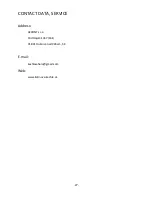
-22-
flexible part of the vacuum cleaner hose to the hole revealed after the removal of a
grill till stop, ca 75 cm. Gradually vacuum clean the entire internal section of the
secondary air inlet tube while concurrently ejecting the vacuum cleaner hose. Close
the loading door (Fig. 1 - position a).
b.
Put the secondary air flap (Fig. 1 - position e) to the maximum position. Slightly
insert the vacuum cleaner hose with the relevant diameter via any of the revealed
secondary air sucking hose to the sucking system, ca 30 to 40 cm. Gradually
vacuum clean the remaining section of secondary air supply, while concurrently
taking out the vacuum cleaner hose from the sucking branch of secondary air (Fig. 1
- position e).
11.
The cleaning of the glass on loading door. Open the loading door (Fig. 1 - position a) and
using the cleaning agent intended for that purpose (you can buy it in the fireplace and
stove shop, together with instructions) clean the glass from both sides.
12.
As long as you need to replace the seals on the stove (cement, or sealing tapes and cords),
let the serviceman trained by the manufacturer to do the replacement, since these are
more demanding actions. (Some sealing tapes and cords are specially manufactured and
modified by manufacturer and their supply and replacement shall be provided for just by
the authorised vendor).
13.
The maintenance of stove surface: use protection means intended for eyes and hands,
working clothes and boots.
a.
Clean the surface of the stove with a dry soft cloth in order to free it from dust and
contaminants from up downwards. Non-patinated stove is to be gently polished
using soft cloth (flannel, suede, wool).
b.
Complete bronze-patinated stove is to be gently brushed using brass brush, mainly
its bronze parts, until the surface is bronze-shining. Subsequently, gently wipe the
whole stove, mainly its brass parts, using suede cloth adequately soaked in spirit.
After the complete dry out, polish using suitable soft cloth (flannel, suede, wool).
Gradually apply 2 to 3 layers of heat-resistant transparent (colourless) stove varnish
following its manufacturer`s instructions for use. It is critical to follow all safety
measures, otherwise there is a risk of explosion, fire, or poisoning. This sort of
maintenance is to be carried out only in dedicated premises !
c.
Complete brass-patinated stove, mainly its brass parts, is to be gently, manually
brushed using brass brush until the surface is brass-shining. Subsequently, gently
wipe the whole stove, mainly its brass parts, using salt-and-vinegar-solution-soaked
cloth. Then gently wipe the parts using a sponge adequately soaked in lukewarm
clean water. As soon as possible wipe in order to dry them out using clean dry soft
cloth. After a complete dry out, polish using suitable soft cloth (flannel, suede,
wool). Further procedure see 13b.
d.
The surface of the stove may get damaged if not cleaned properly.
14.
Stove maintenance
a.
The surrounding, interior and surface of the stove should be kept in a clean
condition. Prior to each heating, the grate area should be freed from ash and hard
fuel remnants. From time to time heat more intensively in the stove, at least
continuously for one hour. This will partially clean the stove from inside.
b.
As long as you have the impression the stove heats poorly or it has insufficient







































